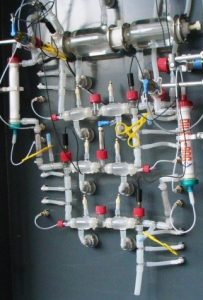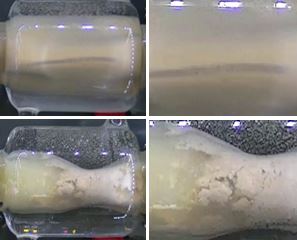This text is meant for healthcare professionals
Critically ill patients often suffer from gastrointestinal problems including high gastric residual volumes as well as diarrhoea and constipation.1Risk factors, clinical consequences, and treatment of enteral feed intolerance during critical illness. Journal of Parenteral and Enteral Nutrition, Published on 2015 May;39(4):441-8 ,2Blaser, A.R, et al. Gastrointestinal function in intensive care patients: terminology, definitions and management. Recommendations of the ESICM Working Group on Abdominal Problems Intensive Care Med. … Continue reading,3Montejo J.C, et al . Enteral nutrition-related gastrointestinal complications in critically ill patients: a multicenter study. The Nutritional and Metabolic Working Group of the Spanish Society of … Continue reading,4Mentec, H, Upper digestive intolerance during enteral nutrition in critically ill patients: frequency, risk factors, and complications. Crit Care Med. Published on 2001 Oct;29(10):1955-61 The presence of gastrointestinal complications is associated with poor clinical outcomes and poor nutritional intake.
Original communication by Gungabissoon et all JPEN 20155Gungabissoon, U, et al. Prevalence, risk factors, clinical consequences, and treatment of enteral feed intolerance during critical illness. Journal of Parenteral and Enteral Nutrition. Published on … Continue reading
The unique protein blend P4 reduces gastric residual volumes
The third most important guideline on how to feed critically ill patients according the 2016 nutritional guidelines developed by the Society of Critical Care Medicine and American Society of Parenteral and Enteral Nutrition (SCCM/ASPEN), indicates the steps that should be taken to improve tolerance to gastric feeding. Danone Research & Innovation has developed the new unique protein blend not only to improve the amino acid quality but also to improve tolerance to gastric feeding .
Patient insights have shown that casein coagulates in the stomach due to its precipitation by gastric acid, while whey protein does not.6Hall, W. L, et al. Casein and whey exert different effects on plasma amino acid profiles, gastrointestinal hormone secretion and appetite. The British Journal of Nutrition. Published on 2003 … Continue reading As a result, gastric emptying of casein is slower compared to whey. Due to the casein clots, gastric emptying of casein is similar to solids, while gastric emptying of whey is similar to liquids and therefore faster. Following the principles of coagulation by gastric acid, at Danone Research & Innovation we performed different in-vitro digestion tests showing that the vegetable proteins pea and soy are non-coagulating like whey and we confirmed in these models that casein is coagulating. The unique P4 protein blend was also shown to be non-coagulating.7Van den Braak, C.C, et al. A novel protein mixture containing vegetable proteins renders enteral nutrition products non-coagulating after in vitro gastric digestion. Clinical Nutrition. Published on … Continue reading After the initial experiments, tube feeding formulas containing the P4 protein blend have been developed and also tested in different in-vitro digestion models, showing that the P4 containing tube feeding formulas do not coagulate while casein dominant enteral nutrition formulas do coagulate.8Van den Braak, C.C, et al. A novel protein mixture containing vegetable proteins renders enteral nutrition products non-coagulating after in vitro gastric digestion. Clinical Nutrition. Published on … Continue reading
TIM model with outcome picture
The coagulation seen in the in-vitro models have been confirmed by an in-vivo study using MRI technique to measure gastric content.9M. Klebach, et al. Effect of Protein Type in Enteral Nutrition Formulas on Coagulation in the Stomach In Vivo: Post Hoc Analyses of a Randomized Controlled Trial With MRI. Journal of Parenteral and … Continue reading Furthermore, we tested a high energy tube feed containing the intact whey dominant P4 protein blend by comparing it with two casein dominant tube feeds in a cross-over, randomised intervention trial showing faster gastric emptying measured by MRI techniques.10Kuyumcu, S, et al. Noncoagulating Enteral Formula Can Empty Faster From the Stomach. Journal of Parenteral and Enteral Nutrition 2014; Issue published: Published on July 1, 2015
The non-coagulating intact whey dominant P4 protein blend with better balanced amino acid pattern (compared to individual protein sources) has been incorporated in most of our tube feeding products.
The unique fibre blend (MF6™) to reduce risk of diarrhoea
Different types of fibres have different effects in the gastrointestinal tract. The soluble and fermentable fibres have important roles in short-chain fatty acid production, maintaining a healthy micro-flora in the gut, fluid and electrolyte absorption and gut integrity. The insoluble fibres play an important role in stool bulking, colon motor activity and bowel transit time. Both are important for the gastrointestinal tract to function properly.11Elia, M, et al. Systematic review and meta-analysis: the clinical and physiological effects of fibre-containing enteral formulae by in Alimentation, Pharmacology & Therapeutics. Published on 2008 … Continue reading
Danone Research & Innovation has developed a unique fibre blend (MF6™) consisting of six different soluble, insoluble, fermentable and non-fermentable fibres. The selection of these six fibres was based on availability in a normal healthy diet and in-vitro digestion experiments at Danone Research & Innovation. The optimal mix was defined having highest short-chain fatty acid production with lowest amount of gas production.13C. J. GREEN Fibre in enteral nutrition. del. del. Clinical Nutrition . Published on (2001) 20(Supplement 1): 23-39 Early clinical trials with MF6™ in healthy volunteers and patients showed positive effects on micro-flora, bowel transit time, diarrhoea and constipation and reduced use of laxatives.14Silk, D.B, et al. The effect of a polymeric enteral formula supplemented with a mixture of six fibres on normal human bowel function and colonic motility. Clin Nutr. Published on 2001, 20 (1): 49-58 ,15Schneider S.M, et al. Effects of total enteral nutrition supplemented with a multi-fibre mix on faecal short-chain fatty acids and microbiota. Clin Nutr. Published on 2006, 25 (1); 82-90 ,16Hofman Z, van Drunen JDE, Brinkman JG, Valerio PG, Tolerance and efficacy of a multi-fibre enriched tube-feed in paediatric burn patients. Clin Nutr. Published on 2001;20 (Suppl 3): 63–64 (abstract) ,17Trier E, Wells JCK, Thomas AG, Effects of a multifibre supplemented paediatric enteral feed on gastrointestinal function. J Pediatr Gastroenterol Nutr. Published on 1999;27:595 (abstract) ,18Wierdsma NJ, Kruizenga HM, Droop A, Arjaans W, Stok A, van Bokhorst-de van der Schueren M, Voedingsvezel in sondevoeding. Een vergelijking van een voeding met guargom met een voeding met vezelmix … Continue reading,19Daly, et al. Is fibre supplementation in paediatric sip feeds beneficial? J Hum Nutr Diet. Published on 2004 Aug;17(4):365-70 A more recent trial comparing the MF6™ containing enteral formula with a fibre-free formula in patients with acute pancreatitis showed less overall complications and shorter hospital stay.20Karakan, T, Comparison of early enteral nutrition in severe acute pancreatitis with prebiotic fiber supplementation versus standard enteral solution: A prospective randomized double-blind study. … Continue reading Furthermore, two recent, randomised clinical trials in hospitalised patients21Jakobsen L.H, et al. Gastrointestinal tolerance and plasma status of carotenoids, EPA and DHA with a fiber-enriched tube feed in hospitalized patients initiated on tube nutrition: Randomized … Continue reading and ICU patients showed22Enteral nutrition preference in critical care: fibre-enriched or fibre-free? Hatice Yagmurdur MD, Figen Leblebici MD Asia Pac J Clin Nutr, Published on 2016;25(4):740-746 that patients receiving the MF6™ containing enteral formulas had less diarrhoea.
The Danone Research & Innovation contribution to immuno-nutrition guidelines
Improving clinical outcomes by modifying nutritional support towards nutritional therapy by means of immune-modulating nutrition has dominated the scientific agenda in the recent past years. Adding high amounts of anti-oxidants, fish-oils and glutamine to tube-feeding formulas seemed very promising. Previous guidelines indicated that high doses of these nutrients should be considered.23McClave SA, Martindale RG, Vanek VW, McCarthy M, Roberts P, Taylor B, et al. Guidelines for the Provision and Assessment of Nutrition Support Therapy in the Adult Critically Ill Patient: Society of … Continue reading However, several large randomised clinical trials24Andrews PJ, Avenell A, Noble DW, Campbell MK, Croal BL, Simpson WG, et al. Randomised trial of glutamine, selenium, or both, to supplement parenteral nutrition for critically ill patients. BMJ. … Continue reading,25Heyland D, Muscedere J, Wischmeyer PE, Cook D, Jones G, Albert M, et al. A randomized trial of glutamine and antioxidants in critically ill patients. N Engl J Med. Published on 2013; 368:1489-97 ,26Rice TW, Wheeler AP, Thompson BT, deBoisblanc BP, Steingrub J, Rock P. Enteral omega-3 fatty acid, gamma-linolenic acid, and antioxidant supplementation in acute lung injury. JAMA. Published on 2011; … Continue reading including the Danone Research & Innovation’ MetaPlus trial with an experimental immune modulating tube feeding formula27Arthur R. H. van Zanten, et al. High-ProteinEnteralNutritionEnrichedWithImmune-Modulating Nutrients vs Standard High-Protein Enteral Nutrition and Nosocomial Infections in the ICUA Randomized … Continue reading did not show any benefit when using high dosages of these nutrients in ICU patients. A publication of the MetaPlus post-hoc analysis28Hofman, Z del. et al. Glutamine, fish oil and antioxidants in critical illness: MetaPlus trial post hoc safety analysis. Ann. Intensive Care. Published on (2016) 6:119 as well as a review describing the consequences of the REDOX trial and the MetaPlus trial29Van Zanten AR, Hofman Z, Heyland DK, Consequences of the REDOXS and METAPLUS Trials: The End of an Era of Glutamine and Antioxidant Supplementation for Critically Ill Patients? JPEN J Parenter … Continue reading significantly contributed to changing the guidelines, now indicating that immune-modulating enteral formulas should not be used routinely in medical ICU patients.30McClave, S. A, et al. Guidelines for the Provision and Assessment of Nutrition Support Therapy in the Adult Critically Ill Patient. Journal of Parenteral and Enteral Nutrition. Published on 2016 … Continue reading
Consequences of the REDOXS and METAPLUS Trials: The End of an Era of Glutamine and Antioxidant Supplementation for Critically Ill Patients?
Van Zanten et al, JPEN 201531Consequences of the REDOXS and METAPLUS Trials: The End of an Era of Glutamine and Antioxidant Supplementation for Critically Ill Patients? Van Zanten AR, Hofman Z, Heyland DK JPEN J, Parenter … Continue reading
View References
| 1 | Risk factors, clinical consequences, and treatment of enteral feed intolerance during critical illness. Journal of Parenteral and Enteral Nutrition, Published on 2015 May;39(4):441-8 |
|---|---|
| 2 | Blaser, A.R, et al. Gastrointestinal function in intensive care patients: terminology, definitions and management. Recommendations of the ESICM Working Group on Abdominal Problems Intensive Care Med. Published on (2012) 38:384–394 |
| 3 | Montejo J.C, et al . Enteral nutrition-related gastrointestinal complications in critically ill patients: a multicenter study. The Nutritional and Metabolic Working Group of the Spanish Society of Intensive Care Medicine and Coronary Units. Crit Care Med. Published on 1999 Aug;27(8):1447-53 |
| 4 | Mentec, H, Upper digestive intolerance during enteral nutrition in critically ill patients: frequency, risk factors, and complications. Crit Care Med. Published on 2001 Oct;29(10):1955-61 |
| 5 | Gungabissoon, U, et al. Prevalence, risk factors, clinical consequences, and treatment of enteral feed intolerance during critical illness. Journal of Parenteral and Enteral Nutrition. Published on 2015 May;39(4):441-8 |
| 6 | Hall, W. L, et al. Casein and whey exert different effects on plasma amino acid profiles, gastrointestinal hormone secretion and appetite. The British Journal of Nutrition. Published on 2003 Feb;89(2):239-48 |
| 7, 8 | Van den Braak, C.C, et al. A novel protein mixture containing vegetable proteins renders enteral nutrition products non-coagulating after in vitro gastric digestion. Clinical Nutrition. Published on 2013 Oct;32(5):765-71 |
| 9 | M. Klebach, et al. Effect of Protein Type in Enteral Nutrition Formulas on Coagulation in the Stomach In Vivo: Post Hoc Analyses of a Randomized Controlled Trial With MRI. Journal of Parenteral and Enteral Nutrition Volume 40. Published on Number 1, January 2016 page134-135 |
| 10 | Kuyumcu, S, et al. Noncoagulating Enteral Formula Can Empty Faster From the Stomach. Journal of Parenteral and Enteral Nutrition 2014; Issue published: Published on July 1, 2015 |
| 11, 12 | Elia, M, et al. Systematic review and meta-analysis: the clinical and physiological effects of fibre-containing enteral formulae by in Alimentation, Pharmacology & Therapeutics. Published on 2008 Jan 15;27(2):120-45 |
| 13 | C. J. GREEN Fibre in enteral nutrition. del. del. Clinical Nutrition . Published on (2001) 20(Supplement 1): 23-39 |
| 14 | Silk, D.B, et al. The effect of a polymeric enteral formula supplemented with a mixture of six fibres on normal human bowel function and colonic motility. Clin Nutr. Published on 2001, 20 (1): 49-58 |
| 15 | Schneider S.M, et al. Effects of total enteral nutrition supplemented with a multi-fibre mix on faecal short-chain fatty acids and microbiota. Clin Nutr. Published on 2006, 25 (1); 82-90 |
| 16 | Hofman Z, van Drunen JDE, Brinkman JG, Valerio PG, Tolerance and efficacy of a multi-fibre enriched tube-feed in paediatric burn patients. Clin Nutr. Published on 2001;20 (Suppl 3): 63–64 (abstract) |
| 17 | Trier E, Wells JCK, Thomas AG, Effects of a multifibre supplemented paediatric enteral feed on gastrointestinal function. J Pediatr Gastroenterol Nutr. Published on 1999;27:595 (abstract) |
| 18 | Wierdsma NJ, Kruizenga HM, Droop A, Arjaans W, Stok A, van Bokhorst-de van der Schueren M, Voedingsvezel in sondevoeding. Een vergelijking van een voeding met guargom met een voeding met vezelmix (Comparison of two tube feeding formulas enriched with guar gum or mixed dietary fibres). Ned Tijdsch Dietisten . Published on 2001;56:243–7 |
| 19 | Daly, et al. Is fibre supplementation in paediatric sip feeds beneficial? J Hum Nutr Diet. Published on 2004 Aug;17(4):365-70 |
| 20 | Karakan, T, Comparison of early enteral nutrition in severe acute pancreatitis with prebiotic fiber supplementation versus standard enteral solution: A prospective randomized double-blind study. World Journal of Gastroenterology. Published on 2007 May 21; 13(19): 2733–2737 |
| 21 | Jakobsen L.H, et al. Gastrointestinal tolerance and plasma status of carotenoids, EPA and DHA with a fiber-enriched tube feed in hospitalized patients initiated on tube nutrition: Randomized controlled trial Clin Nutr. Published on 2017 Apr;36(2):380-388 |
| 22 | Enteral nutrition preference in critical care: fibre-enriched or fibre-free? Hatice Yagmurdur MD, Figen Leblebici MD Asia Pac J Clin Nutr, Published on 2016;25(4):740-746 |
| 23 | McClave SA, Martindale RG, Vanek VW, McCarthy M, Roberts P, Taylor B, et al. Guidelines for the Provision and Assessment of Nutrition Support Therapy in the Adult Critically Ill Patient: Society of Critical Care Medicine (SCCM) and American Society for Parenteral and Enteral Nutrition (A.S.P.E.N.) J Parenter Enteral Nutr. Published on 2009; 33:277-316 |
| 24 | Andrews PJ, Avenell A, Noble DW, Campbell MK, Croal BL, Simpson WG, et al. Randomised trial of glutamine, selenium, or both, to supplement parenteral nutrition for critically ill patients. BMJ. Published on 2011; 342:d1542 |
| 25 | Heyland D, Muscedere J, Wischmeyer PE, Cook D, Jones G, Albert M, et al. A randomized trial of glutamine and antioxidants in critically ill patients. N Engl J Med. Published on 2013; 368:1489-97 |
| 26 | Rice TW, Wheeler AP, Thompson BT, deBoisblanc BP, Steingrub J, Rock P. Enteral omega-3 fatty acid, gamma-linolenic acid, and antioxidant supplementation in acute lung injury. JAMA. Published on 2011; 306:1574-81 |
| 27 | Arthur R. H. van Zanten, et al. High-ProteinEnteralNutritionEnrichedWithImmune-Modulating Nutrients vs Standard High-Protein Enteral Nutrition and Nosocomial Infections in the ICUA Randomized Clinical Trial JAMA. Published on 2014;312(5):514-524. doi :10.1001/jama.2014.7698 |
| 28 | Hofman, Z del. et al. Glutamine, fish oil and antioxidants in critical illness: MetaPlus trial post hoc safety analysis. Ann. Intensive Care. Published on (2016) 6:119 |
| 29 | Van Zanten AR, Hofman Z, Heyland DK, Consequences of the REDOXS and METAPLUS Trials: The End of an Era of Glutamine and Antioxidant Supplementation for Critically Ill Patients? JPEN J Parenter Enteral Nutr. 2015 Nov;39(8):890-2. Epub, Published on 2015 Jan 7. No abstract available |
| 30 | McClave, S. A, et al. Guidelines for the Provision and Assessment of Nutrition Support Therapy in the Adult Critically Ill Patient. Journal of Parenteral and Enteral Nutrition. Published on 2016 Volume: 40 issue: 2, page(s): 159-211 |
| 31 | Consequences of the REDOXS and METAPLUS Trials: The End of an Era of Glutamine and Antioxidant Supplementation for Critically Ill Patients? Van Zanten AR, Hofman Z, Heyland DK JPEN J, Parenter Enteral Nutr. Published on Epub 2015 Jan 7. No abstract available 10.1177/0148607114567201 |





